Home | Front Page | Index | Blog | New | Contact | Site Map
Quiz Answer: Rio Dulce, Guatemala
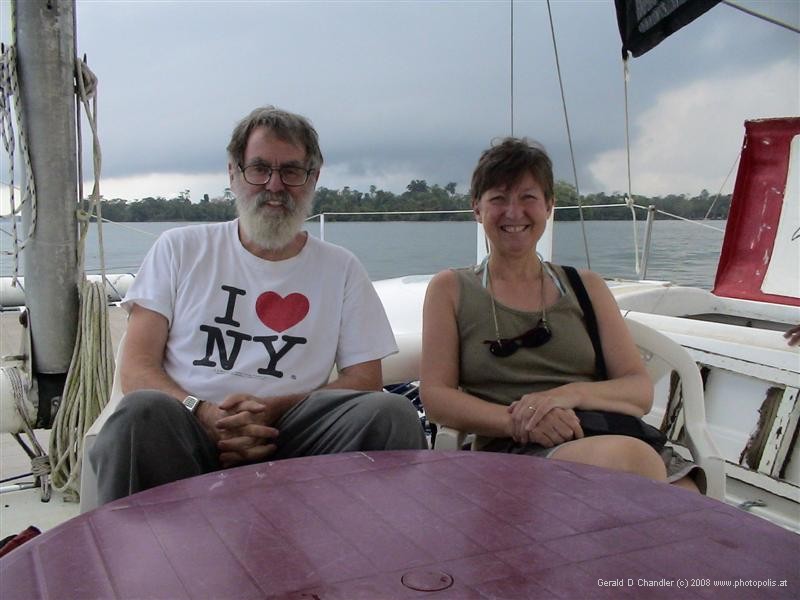
You see us in a very usual occupation: relaxing. This time it is on a catamaran on the Rio Dulce going from the town of Rio Dulce to the port of Livingston, all in Guatemala. We found that we could have this boat for just five us of (the other three we met the night before departure) for only a bit more than a noisy "collectivo" trip along the river in a small power boat with ten other people.
Travel
2004
| 2003
| 2002
| 2001
| 2000
Year In Review
Book Reviews
GerryGrumbling
JanJotting
Jokes
Jan's Resume
Friends' Pages
Recommended Links
Mexico 2004
Belize
Guatemala
Honduras
Nicaragua
Costa Rica
Panama
Virginia
North Carolina
South Carolina
Georgia
Florida
Alabama
Louisiana
Texas
Arizona
California
Nevada
Egypt (Jan, 2002)
Israel (Feb-Mar, 2002)
Turkey (Apr-May 2002)
Bulgaria (early June, 2002)
Romania (early June, 2002)
Ukraine (June, 2002)
Poland (July, 2002)
Prague (July, 2002)
Britain (Aug-Sep) 2002
USA (Oct-Dec) 2002
Batteries recharged, and new toys in hand, we left Texas in late November for a return to Mexico and places further south. A rather long time has passed since we left and until now we haven't updated our web pages In case you haven't heard from us, here's what we've been up to in brief. If we ever get to a place where we have both a reliable connection and enough time to do all the work to update the main web, we'll do it. But for now, here's the summary.
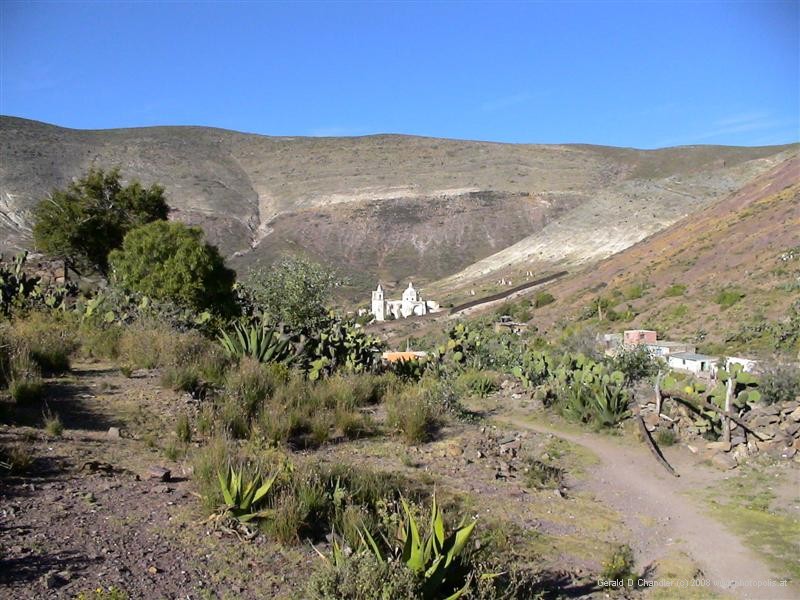
Church on outskirts of Real de Qatorce
|
November - December, Mexico
We pick up our interrupted trip through Mexico in the old silver mining village of
Real De Catorce.
We find it a bit cold and a bit disappointing given the rave
reviews of it we have had. So we rush on to the colonial cities of
San Luis Potosi,
San Miguel de Allende,
Queretaro, and
Guanajuato.
Queretaro is our clear favorite but all of these places are
worth a visit if only for the wealth of baroque churches they have.
Lots of you will have heard about this part as we emailed a description with pictures of
Mexico's Altiplano.
We skirt around the western side of the capital city and visit Uruapan with the nearby volcano Paracutin and the church of San Juan half-buried in lava. We make brief stops in the state capitals of Morelia and Toluca, making a memorable drive up to the Nevado de Toluca, a peak that towers over the city and is snow-covered for part of the year. We arrive the week before Christmas in Patzcuaro, a gorgeous little colonial town with a wonderfully-proportioned central square and were delighted to experience a traditional "Posada", procession and nativity play all in one.
For Christmas we're in Taxco, the biggest little silver shop in the world, and like it in spite of the commercialism for its gutsy layout clinging to narrow ridges and steep slopes. We complete our circle around Mexico City and get to Puebla on the capital's east side for New Year's. We celebrate the New Year by attending midnight mass at Puebla's gorgeous baroque cathedral. We even understand most of the Bishop's sermon.
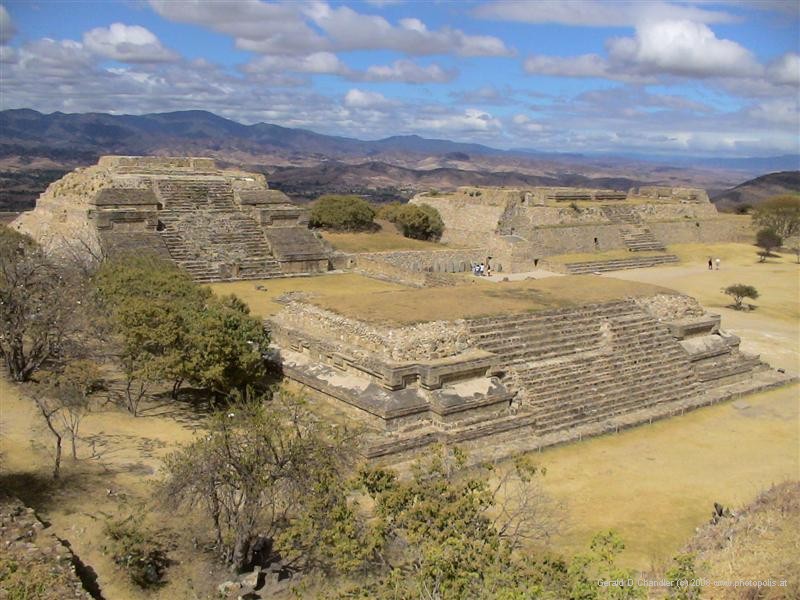
Monte Alban (Oaxaca) Main Plaza |
January - Mexico
We're running out of time fast in Mexico as our visas expire Jan 26. So we head south for Oaxaca to drink chocolate and visit Monte Alban, a marvellous zapotec site. Gerry gets an extremely inflamed throat that makes it difficult to swallow or talk but we find a good doctor and he soon starts to get well again.
The second week of January find us shivering in our shoes again as we climb to the heights of Chiapas for a few days in the lovely old town of San Cristobal. In spite of old warnings about driving in Chiapas, we safely and most enjoyably drive from the cool uplands of San Cristobal to the steamy lowlands of the state at Palenque.
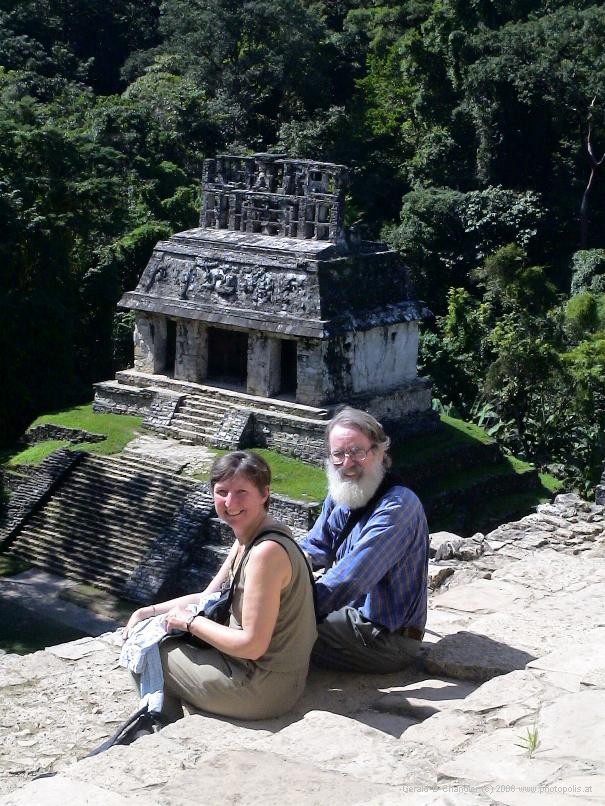
Jan and Gerry on the Pyramid of the Sun, Palenque |
In Palenque we have our first encounter with Mayan architecture. We're entranced by it and think there can certainly be nothing to equal it.
Individually, perhaps, the Mayan sites are not spectacular when compared by age with the Egyptian pyramids, or by beauty with sites like Ephesus, Turkey, but the size and quality of the remains here must be multiplied many times over to encompass all of the sites scattered throughout southern Mexico and Central America. We think they are impressive indeed when this scale is taken into account.
But we have to press on, leaving Chiapas for the Yucatan peninsula. We had claimed this as our ultimate goal when we entered Mexico in August 2003 but we hardly believed we would get here. Driving along mercifully flat and fast roads, we hopped from colonial city to archeological site and back again enjoying Campeche, Uxmal, Merida, Chichen Itza, Coba, and Tulum. We finished the month taking it easy on the shore of Lake Bacalar just north of the Mexico-Belize border town of Chetumal.
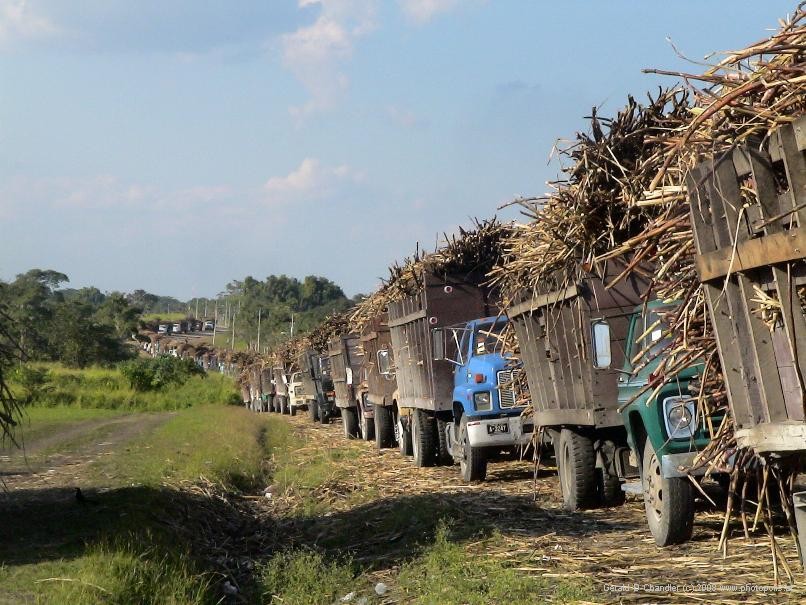
Sugar Cane Harvest, Orange Walk, Belize |
February - Belize
We cross the border into Belize and immediately sit down for a week so that Jan can get treatment for a nasty cold. Our first base is Orange Walk where we see the sugar cane harvest in full force. We drive through Mennonite farm country to see the small but lovely Mayan site at Lamanai. Then it's on to Belize City, the most unmemorable place we have visited so far and on again to San Ignacio a little oasis not far from the Belize-Guatemalan border. Jan is still fighting her cold and here finally beats it by spending four days resting. While she is coddling herself, Gerry runs around to all the neighboring Mayan sites: Cahal Pech, Xunantunich, and El Pilar and we get to know Dirk Harlacher, a young German doing what we're doing in about half the time!
Just as we're about to cross the border, we change our minds and drive down to the beach at Placencia and spend a pleasant few days although it is marred by a bad bout of sunburn for both of us. Then it's back to San Ignacio for lunch before we cross the border into Guatemala just before the middle of the month.

Temple II at Tikal |
February/March - Guatemala
Our first stop in Guatemala was the famous Mayan city of Tikal where we saw the second of the great trio: Palenque - Tikal - Copan (Honduras). Here we found something to more than equal Palenque. We rate it a must-see for everyone. It is a magical place where you get to see four giant temples and many more smaller buildings built by the Mayans while listening to the howler monkeys howl, the toucans touc, the brown jays jay, the parrots parrot.... well, you get the picture. Wildlife and ancient history in a very easy to take package.
A brief stay in Flores on the shores of lake Peten Itza came next including a day tour by road and river to see the Mayan stelas of Ceibal. The remains were rather underwhelming, but the site was an amazing jungle world of tall, tall trees covered with mosses, wreathed with Tarzan-style hanging vines, and inundated with mosquitoes. Then off to Coban in mid-country starting with 10 miles over dirt roads and taking a ferry across a river to find it There we had our first taste of Guatemala's many mountains. We visited a coffee plantation, a private museum of Mayan artifacts, and hiked in a national park devoted to Quetzals, the national bird, but failed to catch even a glimpse of one.
From Coban, we followed the road across more mountains and down to Guatemala City, the "new" capital, founded in the middle of the 18th century. Most of Guatemala City is dirty and impoverished and, we are told, violent. We spent our days visiting museums and parks and such citified things. Most interesting perhaps was the 100-year-old three-dimensional map of Guatemala. We also found a doctor to give us each a thorough physical exam. The results seem to be fine although there are some signs that Gerry's high cholesterol might be catching up with him. Time will tell.
Our next stop was Panajachel on Lago de Atitlan, where we settled into a resort hotel that had definitely seen better days. Its poor condition was compensated by the most lovely gardens overlooking the lake and a favorite feature of ours, a swimming pool. Atitlan lake sits in a former volcano crater surrounded by three volcanoes that rise 2000 meters above the 1500 m lake. We liked it — it's very beautiful — but it didn't match published reports. We also made two excursions to visit indigenous markets. Solola was very authentic and reminded us of Cocly, Vietnam. Chichicastenango was for tourists but impressive too because of the sheer number of stall holders trying to sell their wares. The term a "riot" of color must have been invented here.
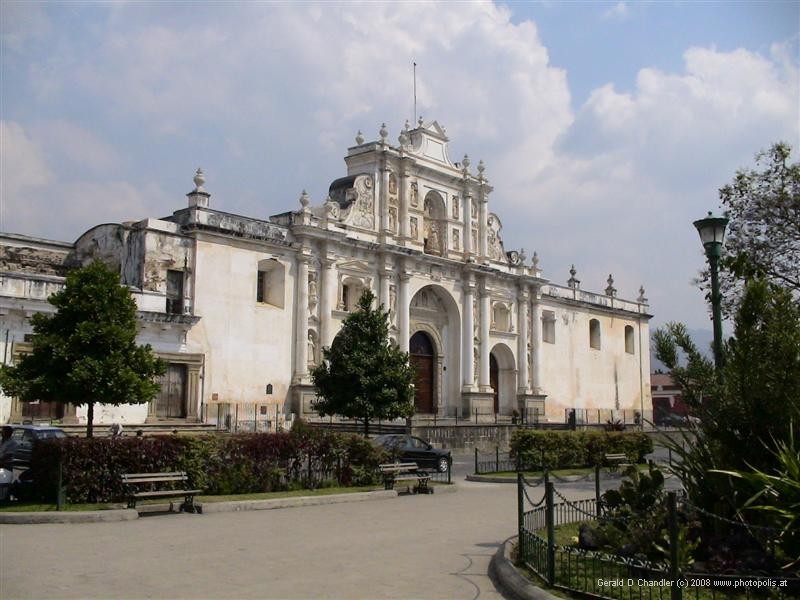
Rebuilt Antigua Cathedral |
But it was almost the end of February and only two weeks remained on the 30-day permit we had for our car, so we rushed off to Antigua, the ancient capital, destroyed by several earth quakes, the biggest in 1773. It was love at first sight for Jan. For us it's the best reason to come to Guatemala after Tikal. Today the town's core has been largely restored to its glorious colonial past. Almost all buildings include a central courtyard, perfect for small hotels and romantic restaurants. As if that isn't enough, every corner you turn reveals another relic from the earthquakes that rocked the city in the 18th century and brought churches crashing down. Few have been rebuilt but they have been stabilised, cleared of rubble, and planted with grass. We loved them.
We would have liked to linger in Antigua but a weekend crush of visitors from Guatemala City forced us out and on past Guatemala City toward Rio Dulce and the Caribbean. Essentially our last stop in Guatemala, we were looking to enjoy Lake Izabal and take a look at the Caribbean. We fulfilled our aims by sharing a Catamaran with three Brits and sailing downriver to the coastal town of Livingston and back again. Livingston is the prototypical Caribbean fishing town, sort of cleaned up for the tourists. It's so tiny that we walked the town from one end to the other in less than 15 minutes; it's so isolated that you can only get there by boat - From Belize or Honduras there are direct ferries.
Now we are playing out the clock. Another day here enjoying the waterfront and seeing the old Spanish fort of San Felipe and we'll be off for a last night in Guatemala at Esquipulas to see the church, Black Christ, and pilgrims, and then the next day we'll cross the border into Honduras and see the last of the Mayan Trilogy, Copan. See you there!